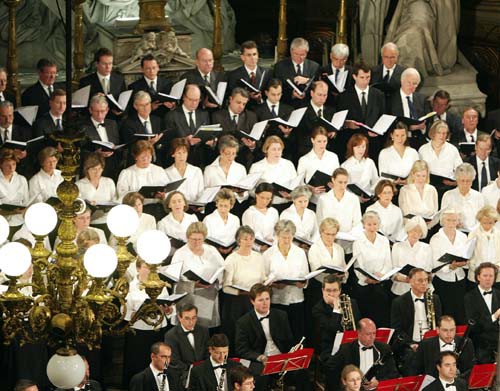Performed for the first time on Advent Sunday, 2 December, 1804, the grandiose music for the consecration and coronation of Napoleon and Josephine composed for two choirs and two orchestras was to lead a chequered career. First of all, almost no one mentioned the first performance. Of all the French press of the period, only one article – appearing in the La Gazette de France, 7 December – gives any details: it mentioned the titles of the pieces played (a mass, a Te Deum, a march and motets Tu es Petrus, Unxerunt Salomonem, Vivat in aeternum, Accingere gladio); named the composers (Paisiello, Le Sueur and the Abbot Roze); and gave a list of the renowned instrumentalists and singers present (the Chef d’orchestre de la musique de l’empereur (Emperor’s conductor), Rey, the violinist Kreutzer (for whom Beethoven wrote his celebrated sonata), the divas, Madame Branchu (soprano), Monsieur Nourrit (tenor) and Monsieur Laïs (bass), to name but the best known today). Not really very much for an event of such importance. Even worse, the most widely distributed text recounting the ceremony, the Procès-Verbal or minutes of the service, published in 1805, hardly mentions the musical items at all. Two years following this publication, a sumptuously illustrated Description of the event was published (in a huge format) by Napoleon’s official architects Percier et Fontaine, and in it there were further, fleeting references to the music (but which fortunately gave more information that the article published in the Gazette de France), namely that the 500 singers and players were arranged in two orchestras and choirs and perched on two grandstands specially built at either extremity of the crossing of Notre-Dame. Percier and Fontaine’s Description was however a limited edition and very costly. It was therefore not widely read. As a result, the music was largely forgotten.
However, what really capped the complete confusion regarding the musical elements performed at Napoleon’s coronation was a piece of disinformation published thirty after the event. Le Sueur, the director of the music at the coronation ceremony itself and composer of several of the march and motets (Tu es Petrus performed for the entry of Pius VII, Unxerunt salomonem, sung during the anointing of Napoleon and Josephine, and Accingere gladio sung during the presentation of the coronation sword of Charlemagne) boasted in 1837 that the music performed at the coronation was an oratorio which he had written. As we have seen, this is a little ‘creative’, to say the least. And so, despite the fact that the renowned Napoleonic historian Frédéric Masson, with his usual care, had noted (in 1907) Paisiello as composer of the mass and the Te deum, for more than 150 years, musicologist specialists of Le Sueur had followed this red herring, stating the latter as composer of the music performed at the coronation.
During the 1960s, the French musicologist Jean Mongrédien – specialist of French music of the First Empire period – was performing research for his doctoral thesis at the Paris Conservatoir in rue de Madrid. In amongst other music also from the Tuileries chapel during the First Empire period, he happened almost by accident upon a box containing the performing score and parts for the music performed on that 2 December 1804. Only two motets remained lost, namely the Accingere gladio (by Le Sueur) and the Veni sancte spiritus (unknown author). A first (partial) performance of the music by Paisiello (only part of the mass) took place in Saint-Louis de Invalides in 1969 for the bicentenary of the birth of Napoleon. It was not until Professor Mongrédien received financial assistance from the Fondation Napoléon that a transcription of all the music unearthed could be undertaken. The whole collection was performed for the first time since 1804 in 1993 at the Festival de La Chaise-Dieu. A recording of this concert was to be made two years later. Since then, there have been only very few performances, three in 2002 in Paris by the choir Musicanti and the Académie Symphonique de Paris under the direction of Peter Hicks, two in 2004, one in Festival de La Chaise-Dieu in the summer and another on the bicentenary itself, at the Madeleine, organised by the Fondation Napoléon – see photo above.
Powerful and triumphal, Le Sueur’s music speaks for itself. The ‘marche guerrière’ (Warrior March) or ‘Marche du sacre’ (Coronation March) was to be re-used for the coronation of Charles X, his papal anthem Tu es Petrus was performed on 14 June, 1856, at Notre-Dame for the baptism of the Prince Impérial, since the pope was once again presiding. Abbot Roze’s Vivat is a very effective piece and was particularly successful in military circles. But what can be said of the music of Paisiello? Totally unlike that of Mozart or Haydn, and far from the Romantic excesses of Cherubini, it is clear, ‘sunny’, simple and happy, the confident product of the Naples, the centre of the musical world at the turn of the 18th century. And it has been unjustly criticised – see for example the comments by A. Mafra in the Lyon local newspaper, Petites Affiches Lyonaises (28/8-3/9/04) : « music lovers [were] ambushed by the Cérémonie du Sacre de Napoléon Ier ». Let us leave the last word to the Emperor himself. In his novella, Clisson et Eugénie (1795) Napoleon has the main character compare his beloved to the music of Paisiello, « Eugénie was like a piece by Paisiello ; only those with souls attuned to his music are transported by it. The common people remain untouched » We quite agree.


